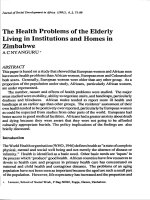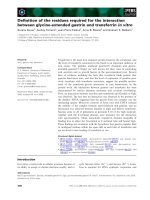Deterrence and Influence in Counterterrorism ppt
Bạn đang xem bản rút gọn của tài liệu. Xem và tải ngay bản đầy đủ của tài liệu tại đây (455.52 KB, 99 trang )
Deterrence
Influence
in
Counterterrorism
A Component in the War on al Qaeda
Paul K. Davis
Brian Michael Jenkins
Prepared for the Defense Advanced Research Projects Agency
R
National Defense Research Institute
Approved for public release; distribution unlimited
RAND is a nonprofit institution that helps improve policy and
decisionmaking through research and analysis. RAND
®
is a registered
trademark. RAND’s publications do not necessarily reflect the
opinions or policies of its research sponsors.
© Copyright 2002 RAND
All rights reserved. No part of this book may be reproduced in any
form by any electronic or mechanical means (including photocopying,
recording, or information storage and retrieval) without permission in
writing from RAND.
Published 2002 by RAND
1700 Main Street, P.O. Box 2138, Santa Monica, CA 90407-2138
1200 South Hayes Street, Arlington, VA 22202-5050
201 North Craig Street, Suite 202, Pittsburgh, PA 15213-1516
RAND URL: />To order RAND documents or to obtain additional information,
contact Distribution Services: Telephone: (310) 451-7002;
Fax: (310) 451-6915; Email:
Library of Congress Cataloging-in-Publication Data
Davis, Paul K., 1943–
Deterrence and influence in counterterrorism : a component in the war on
al Qaeda / Paul K. Davis, Brian Michael Jenkins.
p. cm.
“MR-1619.”
Includes bibliographical references.
ISBN 0-8330-3286-0
1. Terrorism—Prevention. 2. Qaida (Organization) 3. September 11 Terrorist
Attacks, 2001. I. Jenkins, Brian Michael. II.Title.
HV6431 .D3 2002
363.3'2—dc21
2002035800
Cover design by Barbara Angell Caslon
The research described in this report was sponsored by the Defense
Advanced Research Projects Agency. The research was conducted in
RAND’s National Defense Research Institute, a federally funded
research and development center supported by the Office of the
Secretary of Defense, the Joint Staff, the unified commands, and the
defense agencies under Contract DASW01-01-C-0004.
iii
PREFACE
This monograph summarizes the findings of a six-month proj-
ect on deterrence of terrorism, conducted jointly by RAND and
the Institute for Defense Analyses (IDA). The project was initi-
ated at the request of Dr. Anthony Tether, the Director of the
Defense Advanced Research Projects Agency (DARPA). RAND
and IDA worked closely throughout the research and together
held two day-long seminar/discussion meetings with a senior
advisory group. The two organizations, however, developed
separate final reports. These were by no means independent,
because of the extensive prior interchange, but they provided
DARPA with separate “takes” on the issues. The material in
this monograph was initially provided to DARPA as an anno-
tated briefing in July 2002, along with accompanying back-
ground papers.
The project was sponsored by the Director of DARPA and con-
ducted within the Acquisition and Technology Center of RAND’s
National Defense Research Institute (NDRI), a federally funded
research and development center (FFRDC) for the Office of the
Secretary of Defense, the Joint Staff, the defense agencies, and
the unified commands. RAND provided research support funds
to prepare this report.
Comments may be addressed to Paul K. Davis (pdavis@rand.
org), the project leader, or to RAND consultant Brian Jenkins
().
v
CONTENTS
Preface iii
Figures and Tables ix
Summary xi
Acknowledgments xix
Chapter One
INTRODUCTION 1
Objectives 1
Approach 2
Chapter Two
BACKGROUND: WHY DETERRING TERRORISTS IS
SO DIFFICULT 3
Overview 3
Obstacles to Deterrence 3
Terrorist Motivations Are Strong 3
Deterrence and Eradication Do Not Fit Together
Easily 5
Terrorism Is a Way of Life 5
Traditions of Violence Persist in the Clash of
Civilizations 5
There Is No Single Type of Terrorist 7
Chapter Three
PRINCIPLES FOR INFLUENCING TERRORISTS 9
Going Beyond Deterrence 9
Viewing Terrorist Organizations as Complex
Adaptive Systems 13
vi Deterrence and Influence in Counterterrorism
A Broad View of System Influences 13
Decomposing the System into Classes of
Actors 14
Decomposing the System into Classes of
Influence 16
Decomposing the System into a Life-Cycle
Perspective 18
A Decomposition in the Realm of Ideas 20
Other Decompositions 21
Finding Situations Where Influencing Efforts May
Work 22
Conducting a Broad-Front Strategy 23
Developing a Persuasive, High-Minded Strategy 24
Manifest Strength, Purpose, and Determination 25
Relentlessness and Effectiveness 27
Consistency with American Values and Moral
Validity Apparent to Others 27
Balanced Strategy 28
Chapter Four
BROAD ISSUES OF STRATEGY 31
Orchestrating a Broad-Front Strategy 31
Improving the Capacity for Effective Distributed
Decisionmaking and Action 31
Improving the Capacity for Rapid Centralized
Decisions 33
Relationship to the Influence Component of
Counterterrorism 35
The Strategic Significance of Efficiency, Even
in War 36
A Paradigm for Defense 37
Chapter Five
SOME CONTROVERSIAL ISSUES 39
Deterring Acquisition and Use of Weapons of
Mass Destruction 39
Threatening Anyone Who Even Tolerates
WMD-Related Terrorism 40
Deterring Biological Weapons 41
Political Warfare: The Neglected Component of
Antiterrorism Strategy 46
Contents vii
Putting at Risk What the Terrorists Hold Dear 47
Challenges in U.S Saudi Relations 49
Shared Interests but Competing Ideologies 49
The Next Steps 51
The Pakistan Problem 52
Balancing Interests: Realpolitik versus Idealism 53
Upholding American Values in the War Against
al Qaeda 54
Chapter Six
CONCLUSIONS AND RECOMMENDATIONS 59
The Story in Brief 59
Next Steps for Research 61
Appendix
A. Cold War Concepts of Deterrence 63
B. Selected Definitions 67
C. Methods for Analyzing Counterterrorism in a
Complex Adaptive System 69
D. Adapting the Constructs of Effects-Based Planning 73
Bibliography 77
About the Authors 85
ix
FIGURES AND TABLES
Figures
S.1. An Escalation Ladder of the Coerciveness of
Influence xii
3.1. An Escalation Ladder of the Coerciveness of
Influence 10
3.2. Two Types of Terrorists 11
3.3. The Actors in a Terrorist System 15
3.4. A Systemic Perspective 17
3.5. The Life-Cycle Process of Individual Terrorists 19
3.6. A System Decomposition of a Would-Be Martyr’s
Decision 21
C.1. A Simple Game-Structured View 70
C.2. Factors in Red’s Decisions 71
D.1. Effects-Based Operations Operate in Physical
and Cognitive Domains 75
Tables
3.1. Response to Islamist Terrorist Attacks Prior to
September 11 27
5.1. Threatening What the Terrorists and Their
Supporters Hold Dear 48
xi
SUMMARY
PRINCIPLES
This study was initiated by a request to develop a framework
for deterring terrorism. It was subsequently broadened to ad-
dress influence as well, which greatly increased the operating
space for our research (Figure S.1), allowing us to consider
measures ranging from co-optation to full-scale military attacks
executed to deter future terrorist attacks (by al Qaeda or by
others).
This broadening of the problem also reflected a lesson gleaned
from reviewing historical experience with terrorism: Successful
strategies to combat terrorism spawned by serious, deep-rooted
problems have involved first crushing the current threat and
then bringing about changes to make terrorism’s reemergence
less likely. Thus, although concepts such as co-optation and
inducement are not effective for dealing with terrorists who have
the unshakable commitment of a bin Laden, they do apply to
others that the United States must try to influence.
It is a mistake to think of influencing al Qaeda as though it
were a single entity; rather, the targets of U.S. influence are the
many elements of the al Qaeda system, which comprises lead-
ers, lieutenants, financiers, logisticians and other facilitators,
foot soldiers, recruiters, supporting population segments, and
religious or otherwise ideological figures. A particular leader
may not be easily deterrable, but other elements of the system
(e.g., state supporters or wealthy financiers living the good life
while supporting al Qaeda in the shadows) may be. What is
xii Deterrence and Influence in Counterterrorism
Increasing
violence
Deter next time by crushing now
Deter next time by defeating now
Deter next time by punishing now
Deter by denial (defeat the attacks)
Deter by increasing risks and disruption
Deter by threat
Dissuade
Persuade
Induce positively
Co-opt
Hold at risk
what is dear
to our enemies?
Figure S.1—An Escalation Ladder of the Coerciveness
of Influence
needed is a multifaceted strategy that tailors influences to tar-
gets within the system. Terrorists are not a uniform group with
an on-off switch.
Deterrence, likewise, does not have an on-off switch. Although
causing a member of al Qaeda to change his stripes may be out
of the question, deterring individuals from attacking individual
targets is not. To the contrary, the empirical record shows that
even hardened terrorists dislike operational risks and may be
deterred by uncertainty and risk. A foot soldier may willingly
give his life in a suicide mission, and organizations may be
quite willing to sacrifice such pawns, but mission success is
very important and leaders are in some ways risk-averse. Ter-
rorists recognize that their power depends on perceptions of
whether they are winning or losing; their leaders are deeply
concerned with control; and martyrdom in a stymied mission
lacks the appeal of dying in a spectacular, successful attack.
Summary xiii
It is also important to recognize that al Qaeda does not have a
single “center of gravity” whose destruction would bring down
the whole organization. Nor does the United States have the
information that would enable it to pursue such a finely tuned
strategy. Consequently, the United States should adopt a
broad-front strategy aimed at influencing the many different
parts of the al Qaeda system. Where and when the big payoff
will occur is a matter for future historians to ponder. This
approach is feasible because different organs of government
(regular military, special forces, law enforcement, and eco-
nomic, diplomatic, and political elements) can be employed.
Finally, to sustain its effort for the long term, the United States
needs to have and disseminate a persuasive, high-minded
strategy, analogous to the Cold War strategy that served the
nation so well. Key attributes of that strategy should be:
• Manifest strength and, perhaps even more important, mani-
fest purpose and determination.
• Consistency with American values in war and a moral valid-
ity apparent to others with whom the United States needs
to work.
•A balance between efforts to crush a particular terrorist or-
ganization and efforts to mitigate the factors that give the
organization appeal and power (requiring consistent atten-
tion by policymakers and those who execute the strategy).
CROSS-CUTTING ISSUES OF STRATEGY
Turning to more specific issues, we conclude that the following
challenges are of particular cross-cutting significance.
Orchestrating the Broad-Front Strategy
The campaign to defeat al Qaeda cuts across all of the normal
boundaries of war (military, diplomatic, economic, law en-
forcement, etc.). It needs complex orchestration, requiring si-
multaneous initiatives at the polar ends of a dichotomy to de-
velop the following:
xiv Deterrence and Influence in Counterterrorism
• Distributed actions. Theory, doctrine, rules of thumb, rules
of engagement, and information systems are needed to fa-
cilitate near-continual distributed decisionmaking and
timely, effective action by the diverse elements of the U.S.
counterterrorism effort. Timely action is essential because
of the distributed, fleeting, and networked nature of the en-
emy. Centralized command-control is not a good model
here.
• An improved capability for rapid, centralized decisions. No
matter how successful the distributed-decisonmaking effort
is, however, some tactical-level decisions that may have
profound strategic and political effects will have to be made
centrally. Traditional processes for such decisions are
likely to be too slow.
Efficiency
Although effectiveness, not efficiency, is most important in war,
the United States could defeat itself economically by attempting
to do everything everywhere and protect everything too well.
Because U.S. vulnerabilities are essentially infinite, the meth-
ods of systems analysis, including the influence component,
should be applied to the war on terrorism.
Focusing on Adaptiveness, Flexibility, and Robustness
Deterrence depends significantly on convincing organizations
such as al Qaeda and those who support it that any notion of
defeating the United States—much less “bringing the United
States down”—is ridiculous. Although it is unclear whether bin
Laden and his associates ever had such grandiose notions, we
know that the defeat of the Soviet Union in Afghanistan had a
major impact on their thinking. As bin Laden stated in a 1998
interview,
1
______________
1
John Miller, “Greetings America, My Name Is Osama bin Laden,” Esquire,
February 1, 1999, based on an interview conducted in May 1998 (see Frontline,
“Hunting for bin Laden,” />binladen/, updated September 13, 2001).
Summary xv
There is a lesson to learn from this for he who wishes to learn.
. . . The Soviet Union entered Afghanistan in the last week of
1979, and with Allah’s help their flag was folded a few years
later and thrown in the trash, and there was nothing left to
call the Soviet Union.
Even if bin Laden has finite goals, such as causing the United
States to leave Saudi Arabia and back away more generally
from Israel and the Middle East, he has spoken of defeating the
U.S. by hitting its economy,
2
and the zealotry of his agents is
surely enhanced to the extent that the United States is seen as
deeply vulnerable at home. The United States needs to demon-
strate that it will not be brought down and will not close itself
down; it must show that it is resilient and will take any
punches, recover, and hit back very hard. Strengthening ca-
pabilities in this regard will depend on incentives and stan-
dards that encourage modularity, networking, rapid adapta-
tion, and recovery.
TROUBLESOME ISSUES
Weapons of Mass Destruction
A problem of profound concern is the specter of truly catas-
trophic terrorism involving weapons of mass destruction
(WMD), which some terrorists are eager and willing to use. We
suggest two approaches beyond those already being taken. The
first is to credibly announce that any state or nonstate organi-
zation that even tolerates the acquisition of WMD by terrorists
within its borders will be subject to the full wrath of the United
States. It must be clear that the United States will lower stan-
dards of evidence in ascribing guilt and may violate sovereign-
ty; it may preemptively attack and remove regimes by force.
______________
2
Al Jazeera tape, December 28, 2001, and BBC transcripts, December 27,
2001. Quoted from />htm: “We say that the end of the United States is imminent, whether bin
Laden or his followers are alive or dead, for the awakening of the Muslim umma
(nation) has occurred. . . . It is important to hit the economy [of the United
States], which is the base of its military power.”
xvi Deterrence and Influence in Counterterrorism
The relentless U.S. efforts against al Qaeda and the Taliban
have helped in this regard, but causing states to turn actively
against terrorists in their midst who are involved with WMD
presents an additional challenge. Establishing the credibility of
a policy that makes tolerance of such terrorist actions intoler-
able is not easy. Actions will speak louder than words.
The second approach is quite different and controversial:
• Deterrence of the use of biological weapons—a special and
frightening case—could be greatly enhanced if everyone in
the Middle East believed that such an attack on the United
States would inevitably lead to disease spreading into the
Middle East, where huge segments of the population would
die. A first step would be to encourage recognition of the
fact that, because of international travel, infectious diseases
such as smallpox would spread rapidly across borders,
causing a global pandemic.
Political Warfare
Political warfare is an essential component of any campaign. It
should not be confused with the issue of addressing root prob-
lems, although that is also a worthy objective; nor should
apologies be made for its use. Assuring, for example, that
broad-ranging debate occurs within the Middle East (rather
than leaving the field to Islamist extremists) is something that
can be accomplished in ways that are consistent with American
values, including aversion to false propaganda. This subject
needs urgent attention.
Placing at Risk What the Terrorists Hold Dear:
Convincing Regional Allies to Act
One of the lessons learned from reviewing the ways various in-
fluences could be used against the al Qaeda system was that
identifying instruments and targets is the easy part. The hard
part is making something happen, especially when many of the
possible measures would need to be taken by the states from
which terrorists come or in which they reside. America’s Euro-
Summary xvii
pean allies began crackdowns and extensive cooperation with
U.S. authorities soon after September 11. Egypt and Pakistan
are now doing the same, although Pakistani President Mushar-
raf clearly has major political tensions to deal with.
Saudi Arabia is a special case. On the one hand, the United
States and Saudi Arabia have long had a strong strategic rela-
tionship. The two countries continue to have shared interests,
and Saudi Arabia has even attempted to help resolve the
Israeli-Palestinian problem. On the other hand, the spread of
religious fundamentalism in the form sometimes characterized
by Middle East scholars as “Wahhabiism” constitutes a root
problem. It encourages intolerance and can lead to a religious
fanaticism that is certainly not intended by the Saudi govern-
ment, nor is it characteristic of mainstream Islam (which is
practiced by many Saudis).
Looking to the future, if influence is to be a meaningful compo-
nent of counterterrorism, it would seem that the Saudi govern-
ment will need to do much more than it has done so far to
restrain objectionable ideological teachings (and, of course, to
impede the support of foreign organizations that in turn sup-
port terrorism, a subject already much discussed between the
Saudi and U.S. governments).
Balancing Realpolitik and Idealism
The United States faces a dilemma in foreign policy. On the
one hand, working with current Arab heads of state in Saudi
Arabia, Egypt, and elsewhere is very important in the campaign
to crack down on elements of the al Qaeda terrorist system. It
is also important in pursuing the goal of a Palestinian state and
a secure Israel recognized and accepted by its neighbors. On
the other hand, maintaining and improving the quality of coop-
eration will prove difficult if, at the same time, the United
States exerts increased pressure to democratize. This dilemma
has existed for years and, in practice, the United States has not
emphasized democracy as a component of American policy in
the region. Many of the region’s profound problems, however,
including problems of terrorism, are related to the region’s lack
of democratization. It would be in the U.S. interest to promote
xviii Deterrence and Influence in Counterterrorism
open discussion, tolerance, and politically effective compromise
rather than violence. The United States has a variety of in-
struments for this purpose, including increased support of
nongovernment organizations (NGOs) attempting to build civil
societies. The U.S. State Department could take a number of
useful steps if asked to do so. Ultimately, the dilemma is
somewhat artificial: It is possible to work with current state
leaders and to simultaneously encourage democracy.
Upholding American Values
National standards in war are different from standards in a
lengthy peace, but core American values can be preserved in
the war on terrorism. On the foreign front, the United States
should continue to emphasize being discriminate when using
force. It should also demonstrate continued support for dem-
ocracy even when working with nations lacking qualities that
Americans value. Many of America’s Western European allies,
democracies all, have been forced to change laws and processes
to combat terrorism in recent decades. All of them, however,
have found it possible to do so without sacrificing their values.
The best ways to accomplish such adaptations deserve serious
study, with ground rules that permit open-minded rethinking.
On a subject such as incarceration, for example, publicity
about which has worldwide influence on people’s perceptions of
the United States, the goal of speedy justice requires due pro-
cess, but due process does not require the heavy and pon-
derous machinery that we have become accustomed to in
peacetime.
CONCLUDING REMARKS
The concept of deterrence is both too limiting and too naive to
be applicable to the war on terrorism. It is important to con-
ceive an influence component of strategy that has both a
broader range of coercive elements and a range of plausible
positives, some of which we know from history are essential for
long-term success.
xix
ACKNOWLEDGMENTS
We are indebted to our RAND colleagues who either worked on
the project (and participated in many spirited disagreements) or
provided useful comments along the way. These include James
Dobbins, Bruce Hoffman, Jerrold Green, Laurent Murawiec,
Richard Neu, John Parachini, Jonathan Schachter, and Brett
Steele. We also appreciate the close collaboration with the
project team from the Institute for Defense Analyses—Victor
Utgoff (project leader), Brad Roberts, Caroline Ziemke, and Ray
Bonoan. Joe Braddock played a key role in conceiving the need
for the project and sketching initial ideas. Subsequently, he
worked with the RAND and IDA project teams throughout the
project.
The project also benefited from an advisory group chaired by
General Lawrence Welch (USAF, retired) and James Thomson,
presidents of IDA and RAND, respectively. The advisory group
consisted of James Schlesinger, General Andrew Goodpaster
(USA, retired), the honorable Richard Perle, Leon Sloss, Ted
Gold, and Jim Tegnelia.
Finally, we appreciate formal reviews of the draft manuscript by
Jerrold Green and Ambassador L. Paul Bremer.
Although we learned a great deal from interactions with our
colleagues, the reviewers, and the advisory group, the views
presented in this monograph are, of course, our own respon-
sibility.
1
Chapter One
INTRODUCTION
OBJECTIVES
Our initial goal in this study was to describe a framework for
understanding how best to deter terrorists, particularly extrem-
ists targeting the United States and its interests.
1
More
specifically, we were asked to identify those things that terror-
ists—in particular, members of al Qaeda—hold dear and, in
turn, how the United States could place such things at risk.
The work stemmed from a perceived need to supplement on-
going efforts to attack terrorists directly and to defend against
their attacks. During the Cold War, the United States benefited
greatly from having a well-developed and broadly understood
theory of nuclear deterrence, which not only helped guide U.S.
planning, but also established a high ground. NATO strategy
was also built around concepts of deterrence. Those evolving
deterrence concepts were studied and effectively accepted as
legitimate throughout the world. Should the United States not
have a comparably powerful concept of deterrence for the war
on terrorism? After reviewing the issues, we concluded that
Cold War deterrence theory was not, in fact, a very good model
for our purposes, although it did include several important
features that carry over well (see Appendix A). Therefore, we
broadened the subject of our research to include influence,
rather than deterrence alone.
______________
1
The research was performed in collaboration with the Institute for Defense
Analyses (IDA) in a project led by Victor Utgoff (see Bonoan, Davis, Roberts,
Utgoff, and Ziemke (2002) for IDA’s final report).
2 Deterrence and Influence in Counterterrorism
APPROACH
The monograph is organized as follows. Chapter Two provides
background on the difficulty of deterring terrorism. Chapter
Three describes the principles that we found especially helpful
in thinking about a broad framework of influence. Chapter
Four moves from abstractions to more concrete matters, sum-
marizing cross-cutting challenges of strategy that we concluded
are especially important. Chapter Five addresses a series of
controversial issues, one by one. Finally, Chapter Six summa-
rizes our conclusions and recommendations and suggests next
steps for research. The monograph focuses on particular
framework concepts and on troublesome issues, rather than at-
tempting to sketch a comprehensive strategy.
3
Chapter Two
BACKGROUND: WHY DETERRING TERRORISTS
IS SO DIFFICULT
OVERVIEW
This chapter and a companion report (Jenkins, 2002) examine
why deterring terrorism is so difficult.
1
The discussion ad-
dresses motivations, the mismatch with de facto U.S. policy,
the unique characteristics of people involved in terrorist activi-
ties, the long-standing traditions of violence within the Greater
Middle East, and the fact that terrorists vary greatly in charac-
ter, which means that no one approach will apply across the
board.
The difficulties of dealing with terrorism have not always been
apparent to Americans because prior to September 11, 2001,
the United States was perceived as virtually invulnerable. The
difficulties have been more apparent to America’s European
allies and, of course, to Israel.
OBSTACLES TO DETERRENCE
Terrorist Motivations Are Strong
However much we may wish it were not so, terrorism has been
common throughout history; sometimes, it has even succeeded
______________
1
We have drawn on a large body of RAND work on terrorism. See especially
Hoffman (1999) and Lesser, Hoffman, Arquilla, Ronfeldt, and Zanini (1999). A
4 Deterrence and Influence in Counterterrorism
in bringing about change. To imagine that it could be easily
stigmatized out of existence would be both ahistorical and
naive. This is especially so when dealing with people who are
motivated to employ terrorist tactics because they have no
better instruments with which to pursue their aims. Histori-
cally, rebellions against real or perceived oppression have rou-
tinely included the use of terrorism when the rebels did not
have the power to succeed otherwise.
2
Although the United
States hardly sees al Qaeda and comparable groups as “rebels,”
some terrorists (e.g., the Palestinians who use terrorist tactics
against Israel) see themselves that way.
Terrorism is also difficult to combat because those relying on it
may feel they have nothing to lose or because they are moti-
vated by religion or other ideologies in which martyrdom plays
an important role. As is now well known, bin Laden and other
top leaders of al Qaeda are strongly driven by a particular im-
age of Islam and its crusade against the infidels. Bin Laden
may see himself as a prophet or at least as an instrument of
God’s will.
Nevertheless, some terrorists feel constraints and limit their
violence. Unfortunately, the taboo that once existed against
mass-casualty attacks may again have disappeared.
3
We say
“again” because large-scale rape and pillage of cities is hardly
new in history, although the catastrophic potential of nuclear
and weaponized biological agents is. History is not encourag-
ing about the prospect of restraining mass-casualty attacks
once they become the norm, but taboos have certainly been
established and reestablished over time. It is clearly important
to reestablish the taboos in our era (see also Chapter Four).
______________
larger bibliography is available at www.rand.org/publications/bib/SB2060.
pdf. An online source for communitywide bibliographies is .
navy.mil/home/terrorism.htm.
2
See Asprey (1994) and Carr (2002). Our project benefited from a historical
review by Brett Steele (unpublished RAND work, 2002).
3
Roberts (1998).
Background: Why Deterring Terrorists Is So Difficult 5
Deterrence and Eradication Do Not Fit Together
Easily
The concept of deterring terrorism also runs into trouble be-
cause of a mismatch with U.S. policy. The concept of deter-
rence, after all, is ordinarily applied in a quid pro quo sense. It
is not clear, however, that there is any trade to be made here.
Ultimately, the United States is trying to eradicate terrorist or-
ganizations, and those organizations know it.
Terrorism Is a Way of Life
Deterrence is also difficult because for many of the people in-
volved, terrorism is a way of life. Terrorist organizations may
be hurt badly, but those that cause the most concern seldom
go out of existence. For one thing, terrorism provides “pos-
itives”—notably status, power, recruits, and psychological re-
wards. More important than this, however, terrorism is the
very raison d’être of these organizations, so they can can hardly
moderate by disavowing it.
Terrorists are not irrational. Some of them, however, operate in
an introverted, closed universe and may have a high tolerance
for what an outsider would see as drastic conflicts between
their professed beliefs about the world and obvious facts.
4
Traditions of Violence Persist in the Clash of
Civilizations
Combating terrorism is not synonymous with destroying al
Qaeda or other extremist Islamist groups, but al Qaeda is the
major focus today. Unfortunately, many of the most trouble-
some ideas and behaviors are not restricted to extremist groups
but apply to a much larger segment of the Arab world (most no-
tably Saudi Arabia and portions of Egypt). Discussion of this
issue (see Chapter Five) raises hackles because Americans gen-
erally do not wish to tar entire peoples with stereotypical im-
______________
4
Ziemke (2002).
6 Deterrence and Influence in Counterterrorism
ages. Americans believe fundamentally in universalist concepts
such as those underlying the Constitution, concepts also en-
shrined in the United Nations charter. Nonetheless, there is a
clash of cultures.
5
Of primary concern is the question of
whether this clash can be moderated, channeled, and evolved
in benign ways. Denying that it exists will do no good. In par-
ticular, Americans believe fervently in religious tolerance,
whereas Islamist extremists reject it and embrace violence.
Gandhis, they are not. It must also be recognized that portions
of the Arab-Islamic world have long lived with traditions in
which power is fundamental and violence, including terrorism,
is a routine part of gaining and maintaining power.
6,7
When
these cultural legacies are combined with social injustice and
extreme versions of Islamic fundamentalism, the results are not
encouraging: Those who are unhappy may resort to terrorism,
including terrorism against “enemies” such as the West, and
particularly the United States, on which so much is blamed.
8
Another consequence of the culture is that terrorists can have
compelling reasons not to moderate or disband. Leaders who
counsel restraint risk accusations of betrayal and even death at
the hands of those who feel betrayed. Individuals in an organi-
zation may become disillusioned, but in their subculture of fa-
naticism and violence, they often have no easy way out.
______________
5
See Huntington (1993, 1997) and the responses of his critics, many of them
published in Foreign Affairs.
6
See early chapters of Esposito (2002). Although Esposito has written
extensively and sympathetically about political developments in the Arab world,
the early chapters discuss many of the malign influences at work. Our project
also benefited from an unpublished review of such issues by Laurent Murawiec
(RAND).
7
Interestingly, however, a recent survey in the Middle East shows much more
widespread respect for democratic concepts within society than has sometimes
been claimed in clash-of-civilizations discussions. See Richard Morin, “Islam
and Democracy,” Washington Post, April 28, 2002, p. B05. The survey was
conducted by Pippa Norris (Harvard) and Robert Inglehart (University of
Michigan).
8
See Lewis (2002) and Pillar (2001, pp. 29–33) for discussion.
Background: Why Deterring Terrorists Is So Difficult 7
There Is No Single Type of Terrorist
In the Cold War, deterrence operated between two major pow-
ers. Terrorism, however, involves many groups, many instru-
ments, and, often, no central command. Terrorists are not a
single foe, and no simple theory of deterrence can possibly ap-
ply to the spectrum that ranges from anti-U.S. or anti-Israeli
“martyrs” to members of American right-wing militias. To
make things worse, some of the newer terrorists are not moti-
vated to spare innocents, are more generally uninhibited, and
do not calculate thresholds of pain and tolerance in society in
the same way that mainstream terrorists of earlier decades did.
According to accounts, bin Laden has said
9
We—with God’s help—call on every Muslim who believes in
God and wishes to be rewarded to comply with God’s order to
kill the Americans and plunder their money wherever and
whenever they find it. We also call on Muslim ulema, leaders,
youths, and soldiers to launch the raid on Satan’s U.S. troops
and the devil’s supporters allying with them, and to displace
those who are behind them so that they may learn a lesson.
The ruling to kill the Americans and their allies—civilians and
military—is an individual duty for every Muslim who can do it
in any country in which it is possible to do it, in order to lib-
erate the al-Aqsa Mosque and the holy mosque [Mecca] from
their grip, and in order for their armies to move out of all the
lands of Islam, defeated and unable to threaten any Muslim.
While in prison, Sheikh Omar Abdul Rahman (the “blind
sheikh” who was tried in connection with the 1993 World
______________
9
The full text of bin Laden’s February 22, 1998, edict can be found at a
Federation of American Scientists web site, />para/docs/980223-fatwa.htm. See “Jihad Against Jews and Crusaders, World
Islamic Front Statement,” February 22, 1998. The full English text is given at
The original
Arabic can be found at />htm. The quote appeared on the Frontline show “Hunting bin Laden,” http://
www.pbs.org/wgbh/pages/frontline/shows/binladen/
8 Deterrence and Influence in Counterterrorism
Trade Center attack) issued a fatwah, which included the order
to
sink their ships, bring their planes down. Slay them in air, on
land, on water . . . kill them wherever you find them.
10
More recently, Sulemain bu Ghaith, who claims to be a
spokesman for al Qaeda, appeared on an al-Neda website and
said
we have the right to fight them by chemical and biological
weapons so they catch the fatal and unusual diseases Mus-
lims have caught due to U.S. chemical and biological
weapons.
11
Clearly, when dealing with such individuals, the normal forms
of deterrence will not be effective. Moreover, their passionate
hatreds are passed on successfully to other people, even to
children.
12
For these and other reasons, deterrence of such messianic ter-
rorist leaders is likely to be difficult. Nonetheless, there are
opportunities. The next chapter describes key features of a
framework for pursuing deterrence and influence.
______________
10
Bodansky (1999, p. 296).
11
Fox News, June 10, 2002. Quoted by the Emergency Net News Service, http:
//www.emergency.com/2001/ter-advsry-sum.htm.
12
One account describes how youth were motivated by a local Mullah to leave
Pakistan and join up with the Taliban. It tells of a village in which 500 young
boys were entranced by a spellbinding mullah who claimed that “those who die
fighting for God don’t die! Those who go on jihad live forever, in paradise.” In
some cases, at least, their fate could not have been worse. See Jeffrey
Gettleman, “Prisoner of Jihad,” Los Angeles Times, July 21, 2002, p. A.1.
9
Chapter Three
PRINCIPLES FOR INFLUENCING TERRORISTS
This chapter looks at principles for developing a framework for
analyzing deterrence and influence. Most of the principles re-
late to increasing the range of ways to counter al Qaeda (and
terrorism more generally). They deal with (1) broadening the
concept of deterrence to encompass influence, (2) approaching
terrorist organizations as complex systems, (3) finding situa-
tions where influence may work (rather than becoming easily
discouraged), (4) conducting a broad-front attack, and (5) de-
veloping a persuasive, high-minded strategy that can be sus-
tained for years.
GOING BEYOND DETERRENCE
Our study of what terrorists hold dear and how the United
States could deter terrorism by placing those things at risk was
undertaken to supplement direct military and police actions
and defensive measures. However, we concluded that even
when we stretched definitions of deterrence, the concept was
too narrow to use as an organizing principle. As shown in Fig-
ure 3.1, the influence component of counterterrorism provides a
better framework. The spectrum of influences ranges from co-
optation to deterring future actions by crushing terrorists
now.
1
______________
1
Definitions used in this monograph for the terms in Figure 3.1 are given in
Appendix B.









